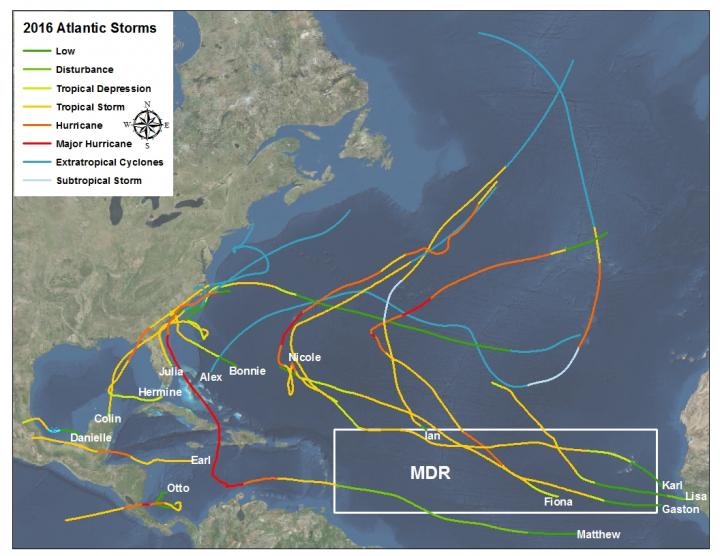2017 hurricane season follows year of extremes

This graphic demonstrates the intensity of the 2016 Atlantic storms. Credit: Daniel Gessman and Chris Mehta, graduate students in the School of Geosciences, University of South Florida
The 2016 Hurricane Season is the longest hurricane season since 1951, making the 2016 season the 2nd longest on record. That's the conclusion drawn in a paper just published in Geophysical Research Letters.
Lead author Jennifer Collins, PhD, associate professor in the School of Geosciences at the University of South Florida in Tampa, FL, writes “Overall 2016 was notable for a series of extremes, some rarely and a few never before observed in the Atlantic basin, a potential harbinger of seasons to come in the face of ongoing global climate change.”
“The 2016 North Atlantic Hurricane Season: A season of Extremes” examines 15 tropical storms, seven hurricanes and three intense hurricanes. The season was slightly above average when considering Accumulated Cyclone Energy (ACE), which the National Oceanic and Atmospheric Administration (NOAA) uses to measure cyclonic activity.
Hurricane Alex started the 2016 season in January, causing minor damage in the Azores. The season ended 318 days later in late November when Otto made landfall over southern Central America. Otto was record-breaking in location and intensity being a high-end Category 2 storm.
In October, Hurricane Matthew became a Category 5 at the southernmost latitude on record for the North Atlantic Ocean. It was the first Category 5 in almost a decade and ended the longest stretch without one since 1950. Matthew claimed more than 600 lives, mainly in Haiti, and caused $15 billion in damage.
Up until that point, conditions had been extremely dry. A dramatic change in relative humidity lead to the month generating more than 50% of the season's ACE. It's also the first October to have two Category 4 or stronger storms.
###
Dr. Jennifer Collins is an American Geophysical Union authorized “hurricane expert.” She is chapter president of the American Meteorology Society (AMS) in west central Florida, which has been recognized by the national AMS as “Chapter of the Year” for the last two years. Her chapter on paleotempestology was published in a book released last month. Her main research area focuses on the interaction between large scale climatic patterns such as the El Niño – Southern Oscillation (ENSO) and seasonal patterns of hurricane activity. She also investigates how hurricane activity varies within the season and examines human behavior relating to hurricane evacuation. She is co-organizing the 6th international “Hurricane and Climate Change” summit in Greece this summer.
Media Contact
All latest news from the category: Earth Sciences
Earth Sciences (also referred to as Geosciences), which deals with basic issues surrounding our planet, plays a vital role in the area of energy and raw materials supply.
Earth Sciences comprises subjects such as geology, geography, geological informatics, paleontology, mineralogy, petrography, crystallography, geophysics, geodesy, glaciology, cartography, photogrammetry, meteorology and seismology, early-warning systems, earthquake research and polar research.
Newest articles

First-of-its-kind study uses remote sensing to monitor plastic debris in rivers and lakes
Remote sensing creates a cost-effective solution to monitoring plastic pollution. A first-of-its-kind study from researchers at the University of Minnesota Twin Cities shows how remote sensing can help monitor and…

Laser-based artificial neuron mimics nerve cell functions at lightning speed
With a processing speed a billion times faster than nature, chip-based laser neuron could help advance AI tasks such as pattern recognition and sequence prediction. Researchers have developed a laser-based…

Optimising the processing of plastic waste
Just one look in the yellow bin reveals a colourful jumble of different types of plastic. However, the purer and more uniform plastic waste is, the easier it is to…



